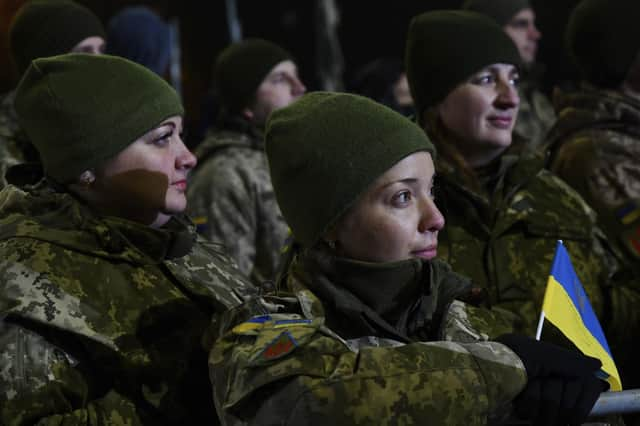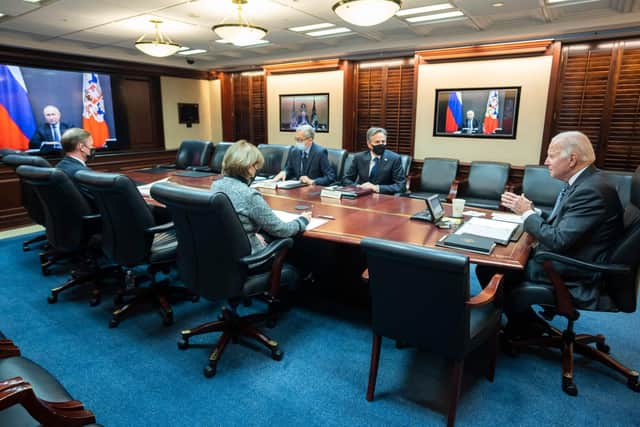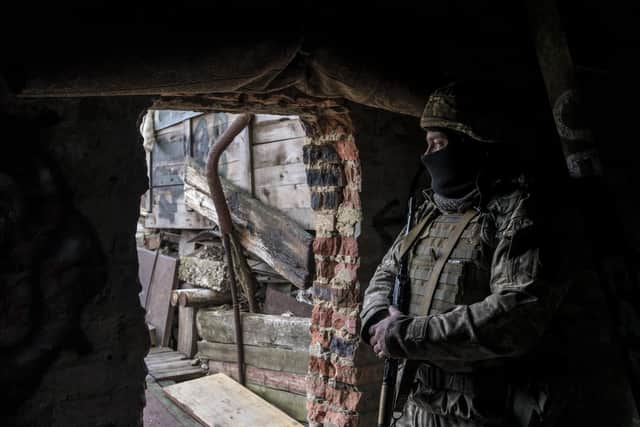Russia Ukraine: Could Russia invade Ukraine? Why Russia has troops on Ukraine border and conflict, explained


According to US and Ukrainian military intelligence, the amassing of thousands of Russian troops on the Russia-Ukraine border in east Ukraine signals the potential for a future invasion on the part of Russian military forces after years of conflict between the two countries.
Tension between Russia and Ukraine has been high since Russia’s annexation of Crimea following the Ukrainian Revolution in 2014, leading to intense conflict between Ukraine and Russia ever since, with an estimated 14,000 people killed over the years.
Advertisement
Hide AdAdvertisement
Hide AdOn January 18th 2022, Ukraine warned that Russia has “almost completed” building up armed forces along the border that could be used for an offensive, exacerbating fears that Moscow could invade at any moment.


But how likely is this to happen, and how have the US, UK and European allies responded to the threat of further Russia-Ukraine conflict so far?
Here’s what you need to know.
Why does Russia have troops on Russia-Ukraine border?
According to the latest intelligence from the Ukrainian Defense Ministry via CNN, Russia has now deployed more than 127,000 troops in the region, including land, sea, and air personnel.


Moscow has denied allegations that Russia is planning to invade, stating instead that the troops are an instance of Ukraine threatening its own action.
Yet Russia’s denial of placing tens of thousands of troops along its western border with Ukraine has jarred with a statement supposedly made by President Putin, according to his foreign adviser Yuri Ushakov, that "the Russian troops are on their own territory, and they don't threaten anyone".
While the overriding narrative of recent troop movements along the Russia-Ukraine border have been interpreted as showing the potential for an invasion of Ukraine by Russian forces, it is also thought that the moves from Russia may be a show of strength in the face of what it views as increased hostility and deference to Ukraine from the US.
Ukraine has also published intelligence assessments showing that Russia is "trying to split and weaken the European Union and NATO", having previously demanded that Ukraine never joins NATO, a move that was rejected by Western powers.
According to a Reuters report on November 23, Moscow identified a ‘significant increase’ in US strategic bomber activity in November – with Russian Defence Minister Sergei Shoigu saying they had carried out 30 flights close to Russia that month, more than twice as much as the same period last year.
Advertisement
Hide AdAdvertisement
Hide AdRussia also claimed that the US had rehearsed a nuclear strike on Russia last month, with US planes coming within less than 20 kilometres of Russian borders.
What would happen if Russia invades Ukraine?
At the beginning of December 2021, there were ongoing talks between President Joe Biden and Putin, where Biden reiterated a need for diplomacy and de-escalation of Russian troop activity on the Russia-Ukraine border.
According to reports, the US President once again stressed that the country would not hesitate to impose sanctions if Moscow were to continue or intensify its “threatening behaviour” toward Ukraine.
With the military situation worsening in the region, US and Russian foreign ministers will hold talks once again in Geneva on Friday January 21st, as a White House official suggests that “perhaps diplomacy is not dead”.
US Secretary of State, Tony Blinken, will also fly to Kiev today, on January 19th, and then Berlin on Thursday January 20th to consult with the Ukrainian government and European allies.
Among the sanctions which could be levied on Russia if it were to take any further steps against Ukraine or attempt to invade the country are sanctions on Russian banks, the SWIFT international payment system and on the $11 billion Nord Stream 2 pipeline, set to bring Russian gas into Europe via Germany.
What have the UK and US said about the Russia-Ukraine border conflict?
The UK and its allies have agreed to work together to encourage Russia to row back from its "threatening behaviour" towards Ukraine.
Prime Minister Boris Johnson and other European leaders took part in talks with US President Joe Biden in December as Western allies consider how to respond to the threat of a Russian incursion into Ukraine.
Advertisement
Hide AdAdvertisement
Hide AdThe call came after Mr Biden held an online meeting with Russian president Vladimir Putin to warn that, in the event of an invasion, the US stands ready to impose sanctions that would exact "a very real cost" on the Russian economy, according to White House officials.
Following the bilateral, Mr Biden then spoke to Mr Johnson, Italian prime minister Mario Draghi, French president Emmanuel Macron and then-German chancellor Angela Merkel as they seek to present a united front against the Kremlin.
It was the second time the five leaders - dubbed the Nato "Quint" - had spoken within 24 hours regarding the diplomatic crisis.
According to Downing Street, the leaders "underlined the importance of Russia ceasing their threatening behaviour towards Ukraine" during the call.
"They agreed on the need for ongoing dialogue with Russia to encourage this outcome," a spokeswoman said.
"The leaders agreed to stay in close contact and to co-ordinate their approaches to this issue."
It follows Mr Johnson telling his fellow leaders that the UK would "continue to use all the economic and diplomatic tools at its disposal" to prevent any Russian aggression against Kiev.
Foreign Office minister Vicky Ford told MPs that the UK was considering "an extension of purely defensive support to Ukraine to help Ukraine defend itself".
Advertisement
Hide AdAdvertisement
Hide AdShe said any "military incursion" by Russia into the eastern European country would be a "strategic mistake".
Additional reporting by PA reporters Patrick Daly and David Hughes
A message from the Editor:
Thank you for reading this article. We're more reliant on your support than ever as the shift in consumer habits brought about by coronavirus impacts our advertisers.
If you haven't already, please consider supporting our trusted, fact-checked journalism by taking out a digital subscription.
Comments
Want to join the conversation? Please or to comment on this article.

